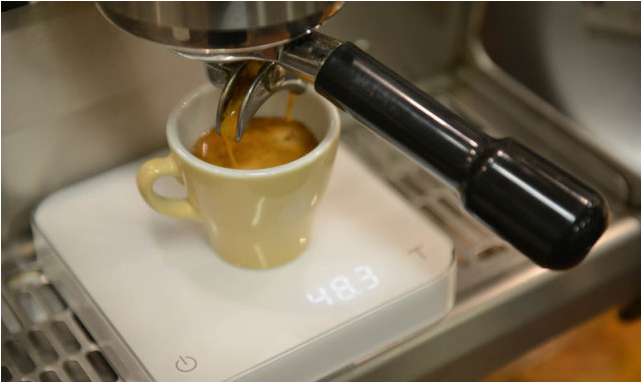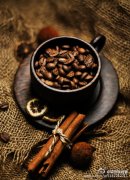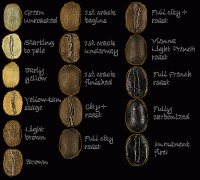[exclusive interview] World Coffee tournament referee Gvelum
Gvelum has been working as a barista since 1997. He has traveled to 36 countries and trained more than 40 baristas. He is the 2009 World Barista Competition (WBC) champion and current World Coffee Championship (World Coffee Events) referee. He is one of the co-founders of Prufrock Cafe and founded a barista training college on the outskirts of Prague, Czechoslovakia. Today, Chongqing Barista barista training School brings an interview with the champion barista of Gvelum barista training College to make a perfect espresso.
Brista Coffee training Institute: Hello, Gvelum! Thank you for coming here to discuss espresso with the Beresta Coffee training Institute. The first question raised by the Beresta Coffee training Institute on behalf of baristas is: what makes the perfect Italian espresso?
Gwaylum: that's a good question. Many baristas have asked me the same question. Only the coffee you think is good is the really high quality espresso. What other people call "perfect coffee" may be worthless in your eyes. Personally, I will use the WBC sensory rating scale to objectively judge the quality of espresso. I like the perfect balance between sour, sweet, bitter and other flavors, as well as the texture and aftertaste of the coffee. I think only Italian espresso with balanced taste, mild bitterness, moderate acidity, rich taste, long-lasting aftertaste and sweetness is really good coffee. If the coffee is not sweet, there will be no balance between the various tastes. The purity, smoothness, long-lasting taste and pleasant aftertaste of coffee are also important criteria for me to judge the quality of coffee. I've never tasted absolutely perfect espresso. Usually, coffee is either lack of sweetness or its aftertaste is not long enough. If we have to define "perfect", I think the sweetness and aftertaste of coffee are the most important.

Brista Coffee training Institute: what details do you pay more attention to when you are trying to make the perfect espresso?
Gvelum: in order, they are: high-quality fresh coffee beans, bean grinder blades sharp enough to grind beans and filter water, be sure to change the filter element of the filter regularly. I think there are two taboos in the process of Italian espresso:
1. Use an uncleaned coffee machine or bean grinder
two。 When making, the distribution of coffee powder in the filter bowl is not uniform.
It's not enough to flatten the coffee powder with your fingers. You must make sure that the coffee powder is evenly distributed at the bottom and top of the filter bowl. I gave up the method of smoothing coffee powder with my hands a long time ago. Now I use the horizontal and vertical smoothing method to make sure that the coffee powder is evenly distributed before it is pressed. The WBC coffee making operation guide has some reference significance, but I think it is far from enough to follow the steps in the guide. I have seen many baristas who can make high-quality coffee in the competition, but in my opinion, they all have some deficiencies if they want to work at Prufrock.
Brista Coffee training Institute: on what basis do you set the parameters? Is it taste, degree of extraction, time or?
Gvelum: I set the production parameters according to the gouache ratio. If there is still something wrong with the taste of the coffee, I will check the extraction time and the degree of extraction. Every time I get a new variety of coffee beans, I usually set the ratio around 50%EBF (coffee powder: total coffee weight = 1:2). I will adjust the total weight of the coffee to improve the sweetness of the coffee according to the sweetness of the coffee. In the past, I used to worry about the taste of coffee all day, but since I started using the gouache ratio test, I can easily adjust and determine the best way to make it. I don't think the extraction time will have much effect on the quality of coffee, as long as you determine the formula, even a 4-second error is not a problem. In my training college, I ask students to make coffee in 19-24 seconds; when I travel to other countries, I make coffee in 27 seconds; at Prufrock, shop assistants can even make coffee in 36-40 seconds. If I want the coffee to taste purer, the time to make it will be shortened accordingly; if I want the coffee to taste better and mellow, it will take longer to make and avoid caffeine taking too long to make it with a charred flavor. thus upsetting the balance of taste. Sometimes I measure the degree of extraction of coffee, but most of the time this is not necessary. As long as you make coffee long enough without a laser scatterer, you can guess how much coffee is extracted.

Brista Coffee training Institute: how do you keep the quality of your coffee constant throughout the day?
Gvelum: if your equipment and coffee beans don't change, the quality of the coffee won't fluctuate much. I attended the London Coffee Festival in 2014, and because of the hot scene, I had to adjust the coffee recipe at the right time in the middle of the day. To answer this question, you have to figure out how the quality of coffee is constant. First of all, coffee beans. Is the solubility of your coffee consistent? Do you use the same blended or single coffee? Is the coffee roasted evenly? The second is the bean grinder. If the blade of the bean grinder is not sharp enough, you will never be able to guarantee the consistent quality of the coffee. In addition, you should make sure the bean grinder is at a constant temperature. The change of temperature will change the amount of powder, the uniformity of grinding, the temperature of coffee powder during extraction and the rate of extraction. The third is the production skills. Is the way you press powder consistent? Are you pressing too hard? Do you check the powder pressure every time? And then there's the coffee machine. Is the temperature of the coffee machine constant? Will the speed of the current increase if it is overheated? Can the coffee machine open two head groups at the same time under the same pressure at the busiest time of the day? Does the pressure inside the coffee machine change over the course of the day? Is the coffee machine clean enough? The change of any factor will lead to the coffee quality can not be kept constant. Be sure to find out which link has gone wrong and solve it in time. If there is a lot of traffic in the coffee shop, you will find that the parameters of the bean grinder will become finer and finer over time, so you have to reset the parameters the next day. In addition, you must help the coffee machine cool down in the afternoon, otherwise the high temperature of the equipment will affect the quality of the coffee.
Brista Coffee training Institute: how often do you clean your coffee machine?
Gvelum: I clean the coffee machine before making every cup of coffee. That's why my coffee is of better quality than most people.
Brista Coffee training Institute: can you tell your friends about the three cups of espresso you have most impressed so far?
Gvelum: I tasted an espresso when I was at the Square Mile event in 2008. The coffee was made by Anette from Coffee Collective Cafe, and that cup of coffee completely upended my view of espresso. I didn't like the smell very much, but I didn't hate it either. I was very confused at that time.
The experience since then has changed my barista trajectory again and again. In March 2013, I visited a trainee in a class run by Petra Vesela near Prague, who made me a cup of coffee from drip-roasted Yekaschafe. The gouache ratio of coffee is about 45%, the cooking time is 22 seconds, and the water temperature is 92 ℃. I have never used lightly roasted beans to make espresso, nor have I ever tried to make Arabica coffee in such a short time and at such a low water temperature. The coffee was well-balanced and unexpectedly sweet, so I called my shop assistant and told him I would be late.
After the 2014 German World Philharmonic pressure Cooking Competition, I drove back to Prague and passed the Machh?rndlKaffee Cafe. At that time, the barista in the shop made me a cup of Italian super-espresso (Ristretto), which was highly extractive but well-balanced. I didn't know it was an espresso, but its taste was unforgettable. It tastes sweet, delicious and has a long finish.
Important Notice :
前街咖啡 FrontStreet Coffee has moved to new addredd:
FrontStreet Coffee Address: 315,Donghua East Road,GuangZhou
Tel:020 38364473
- Prev

Japanese hand Coffee course and Summary Volcano Flushing
Japanese coffee, has a very strong Craftsmanship (craftsman spirit), imagine the Japanese bow, tea, kendo, cuisine, are very ceremonial and exquisite, although not the so-called craftsman, but enough to reflect the connotation of the word Craftsmanship. Now, Japan can call its coffee culture Coffee Road! They give a cup of coffee the highest respect, which
- Next

Basic knowledge of coffee roasting Coffee bean baking
Coffee roasting process is a complex change in chemical and physical properties. People roast green coffee beans into brown finished coffee beans through coffee roasting. Coffee roasting by roasting coffee beans to get a larger coffee bean shape, coffee bean color, coffee bean taste, coffee bean smell, through roasting to make coffee produce different flavor characteristics. Roast coffee beans
Related
- Beginners will see the "Coffee pull flower" guide!
- What is the difference between ice blog purified milk and ordinary milk coffee?
- Why is the Philippines the largest producer of crops in Liberia?
- For coffee extraction, should the fine powder be retained?
- How does extracted espresso fill pressed powder? How much strength does it take to press the powder?
- How to make jasmine cold extract coffee? Is the jasmine + latte good?
- Will this little toy really make the coffee taste better? How does Lily Drip affect coffee extraction?
- Will the action of slapping the filter cup also affect coffee extraction?
- What's the difference between powder-to-water ratio and powder-to-liquid ratio?
- What is the Ethiopian local species? What does it have to do with Heirloom native species?

